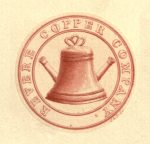
Project Gutenberg's Fifty years with the Revere Copper Co., by S. T. Snow
This eBook is for the use of anyone anywhere at no cost and with
almost no restrictions whatsoever. You may copy it, give it away or
re-use it under the terms of the Project Gutenberg License included
with this eBook or online at www.gutenberg.org
Title: Fifty years with the Revere Copper Co.
A Paper Read at the Stockholders' Meeting held on Monday 24 March 1890
Author: S. T. Snow
Release Date: January 25, 2008 [EBook #24423]
Language: English
Character set encoding: ISO-8859-1
*** START OF THIS PROJECT GUTENBERG EBOOK REVERE COPPER CO. ***
Produced by Martin Pettit and the Online Distributed
Proofreading Team at http://www.pgdp.net (This file was
produced from images generously made available by The
Internet Archive/American Libraries.)

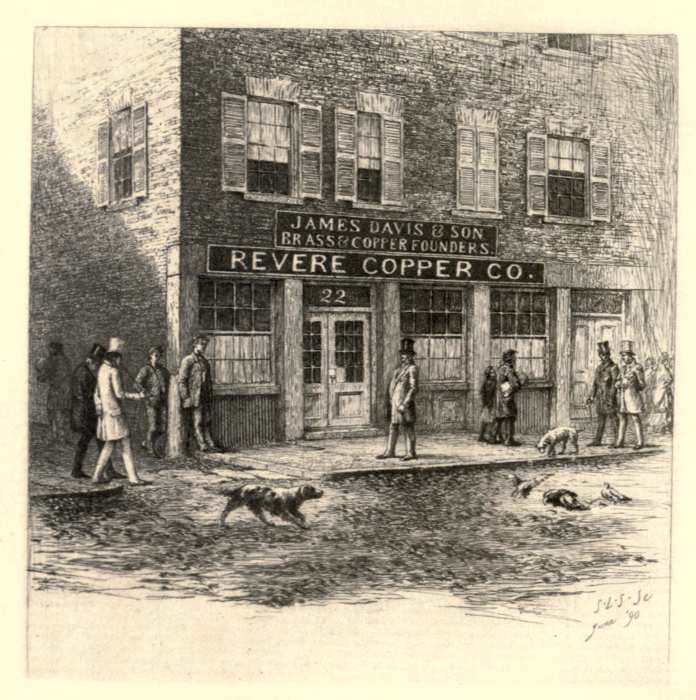
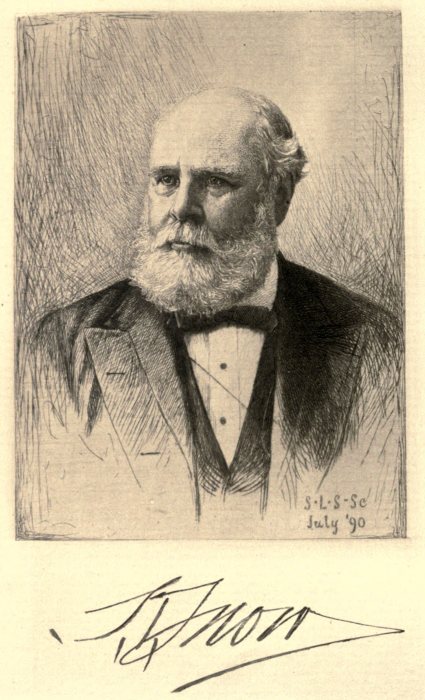
A Personal Word by way of introduction. My first appearance in the Revere Copper Company's office, then at No. 22 Union Street,[1] was on Monday morning, March 23, 1840. Saturday night last, therefore, completed the full period of fifty uninterrupted years of service.
In the nature of things it cannot be expected that this record will be repeated by me, nor can any one else duplicate it for a long time to come. There is no other stockholder whose certificate bears an earlier date than 1881, and[Pg 6] no one in the office has a retrospect of twenty years even.[2]
The Company was incorporated and organized in the year 1828. In 1840, all the original corporators, or associates, were living. Other stockholders from their families were afterwards added, but they all, the first associates and the others subsequently admitted, have passed away. It follows that, at the present time, there is no other one living who has been brought into daily business intercourse with the members of this Company from its very beginning.
It would therefore seem to be a very proper and fitting thing for me, on so interesting an occasion, to review somewhat the personnel of the Company.
[1] The office and storehouse were removed June 1, 1843, to No. 97 State Street; again July 1, 1867, to No. 47 Kilby Street; and still again, November 1, 1888, to No. 369 Atlantic Avenue, where they now are. In the conflagration of November 9 and 10, 1872, the building Nos. 45 and 47 Kilby Street was destroyed. During its reconstruction, just one year, building No. 113 (later 117) State Street, corner of Broad Street, was occupied.
[2] Mr. James Edmiston Brown came into the office February 8, 1873. He deserves special mention here for his faithful, efficient, and valuable services.
Preliminary thereto, however, a brief historical statement should be made of the beginnings of the enterprises to which the Company succeeded.
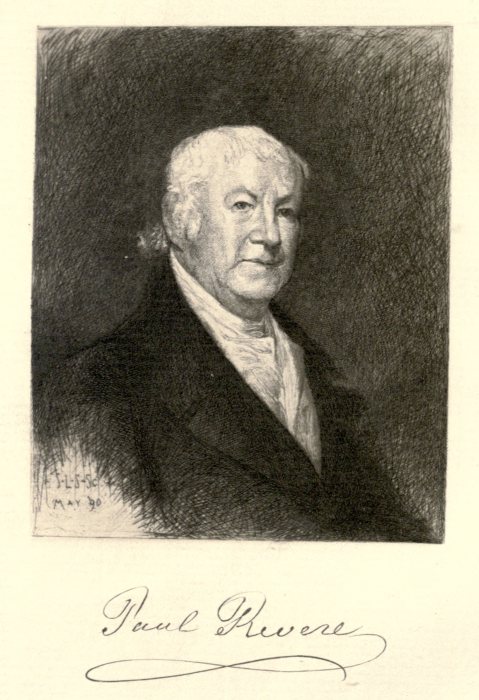
In January, 1801, Colonel Paul Revere[3] bought the old powder-mill at Canton, where during the Revolutionary War, largely by his instrumentality and agency, the Colony and State had been supplied with powder. He and his son, Mr. Joseph W. Revere, under the firm-name of Paul Revere & Son, erected and adapted the buildings necessary for the manufacture of copper into sheets and bars.
In the years 1804 and 1805 Mr. J. W. Revere spent considerable time on a visit to England and the continent for the purpose of obtaining all the information possible in the prosecution of their undertaking.
Colonel Revere claims, in letters written by him at the time, that their mill for rolling copper was the first erected in this country.[4] And it may be said in passing that the copper trade in England was hardly more advanced there than here.
Their business grew slowly, but it made a steady progress until substantially established. Colonel Revere died in 1818, but the son, Mr. Joseph W. Revere, continued on with the manufactory started at Canton until it became a part of the incorporated Company.
Singularly coincident with the events already narrated, Mr. James Davis, but five months younger than Mr. Joseph W. Revere, had come to Boston from Barnstable, his native town, and acquired here a trade, reaching his majority in 1798.
In the very first years of the present century he established himself on Union Street as a brass founder. Here he continued, gradually expanding the business until the admission of his son, Mr. James Davis, Jr., as a partner, January 4, 1828, when the firm-name of James Davis & Son was adopted.
These two enterprises naturally ran along very much together in certain respects. For instance, in their trade with shipbuilders, which was an important feature with each; while the foundry was turning out composition castings required for fastenings, the mill was [Pg 10]preparing copper in its various forms for use on the same vessel.
It was therefore to be expected that the rapid revival of our mercantile marine after the close of the second war, giving to both these firms a largely increased trade, would bring them into very intimate relations and suggest to them the wisdom of a more permanent union.
Out of these conditions finally grew the incorporated Company, taking the family name of its real founder, and known since as the Revere Copper Company.
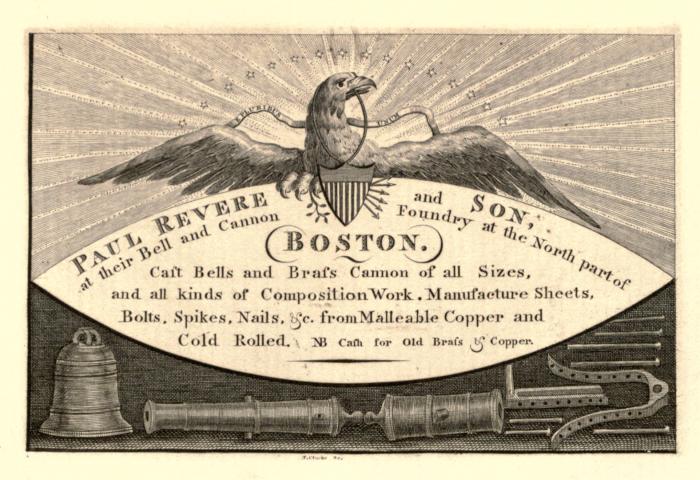
The card on the opposite page is printed from the original copperplate, which must have been engraved earlier than the year 1804. In that year the foundry described as "at the north part of Boston," which was on Lynn Street,[5] was so seriously damaged in a severe gale that it was not afterwards repaired nor occupied; its contents and the work done there were transferred to the copper-mill at Canton.
The plate is in possession of the present Mr. J. W. Revere, son of the late Mr. John Revere, and has been kindly loaned for use here.
[3] He was commissioned by Governor Shirley, February 29, 1756, as lieutenant of artillery "for service in the expedition to Crown Point, under command of General John Winslow"; by a majority of the Council, then at Watertown, April 10, 1776, as major in the regiment commanded by Colonel Josiah Whitney, "for service in the defence of Boston Harbor"; and by the same authority, November 29, 1776, as lieutenant-colonel of artillery, "for defence of the State and for the immediate defence of the town and harbor of Boston," under command of Colonel Thomas Crafts.
Thereafter he was always known by his neighbors and townspeople as "Colonel Revere."
[4] "The Copper Works of the Messrs. Revere are referred to by various writers as of Boston; Bishop saying that 'in 1802 the only manufactory of sheet copper in the country was that of the Messrs. Revere at Boston.' The facts are that while this firm made Boston the headquarters of its business the manufactory was at Canton where soon after the war $25,000 had been invested in a plant."—The Memorial History of Boston, vol. iv, page 81.
[5] In 1800 Lynn Street extended from Winnisimmet Ferry to Charles River Bridge. In 1833 it was merged into Commercial Street.
The original Charter of this Company was approved by Governor Levi Lincoln, June 12, 1828. The corporators named therein were J. W. Revere and F. W. Lincoln.
The charter has been amended by approval of Governor George N. Briggs, January 29, 1845, and again later by approval of Governor Henry J. Gardner, March 9, 1855.
At the first meeting of the corporators held, for organization, at Mr. Revere's counting-room, No. 75 Kilby Street, Friday, July 25, 1828, two other names were added, and the four stand recorded in the following order:—
| JOSEPH W. REVERE. |
| JAMES DAVIS. |
| FREDERICK W. LINCOLN. |
| JAMES DAVIS, Jr. |
These accordingly, although not enumerated in the original Act, have always been spoken of as the corporators or original associates.
The office of the Revere Copper Company in 1840, as shown in the frontispiece hereto, occupied so much of the building on Union Street as had previously been devoted by Mr. Davis to a shop, wherein were displayed the wares kept by him for sale, and still earlier had been used by Mr. Gay for the same purpose.
Joseph Warren Revere, so named for General Joseph Warren who was killed at the battle of Bunker Hill, and with whom his father, Colonel Revere, had been intimately associated in the uprising of the colonies, was the third son of Paul and Rachel (Walker) Revere.
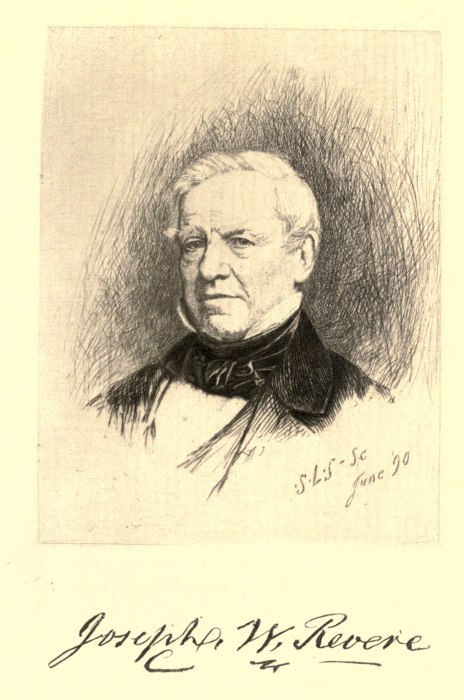
He was born at his father's house in North Square, Boston, April 30, 1777. His father was absent at the time in the interest of the colony, and was so constantly occupied in public affairs that he did not return to take up again a permanent residence with his family until the son was about three years old.
The son, in 1801, became a partner in business with his father, and so continued until [Pg 15]his father's death in 1818. His mother died June 19, 1813.
He was a Director and the first President of the Company, and continued to fill these offices until his death, which took place at his summer home in Canton, after a somewhat lingering illness, October 12, 1868.
Mr. Revere grew up, and was deeply impressed with the stirring events of the Revolutionary War; the settlements following peace; the adoption of the Federal Constitution; the administrations of Washington and Adams, and the final formation of parties which led to the defeat of Adams for a second term and the election of Jefferson. It is not strange, therefore, that he was a consistent Federalist, and subsequently belonged to the old Whig party; that he venerated the worthies of the republic, Washington, Franklin, and Lafayette, of national renown; Josiah Quincy, Sam. Adams, and others of the State;[Pg 16] and was an admirer of those who, like Clay and Webster, continued in later years to labor with the same devotion to the good and glory of a newborn and rising nation.
His whole character seemed to have been formed of soberer and more profound elements than in after years were generally recognized as constituting the prevailing types.
Mr. Revere was one of the original members of the Boston Light Infantry, whose first parade took place October 18, 1798, under command of Captain Daniel Sargent; and was the last survivor of the original membership.[6]
His patriotism, inherited from a distinguished father, was pronounced, and remained unshaken at the advanced age of nearly four-score years and ten, through the terrible ordeal of parting with two sons killed, one at[Pg 17] Antietam and the other at Gettysburg, while contending for the existence of a government their grandfather had exerted himself so grandly in the struggle to establish.
Devoted and affectionate in his domestic relations; thorough, prudent, and sagacious in business; impatient with meanness and strong in his resentment of wrong; kind and considerate to those deserving his confidence; courtly in bearing, while genial and sunny in his familiar intercourse, he has left for us all a very precious memory. Every recollection of him is simply delightful.
[6] From an unpublished History of the Boston Light Infantry. By William W. Clapp, Esq.
James Davis was the second son of James and Reliance (Cobb) Davis, and was born in Barnstable September 28, 1777.
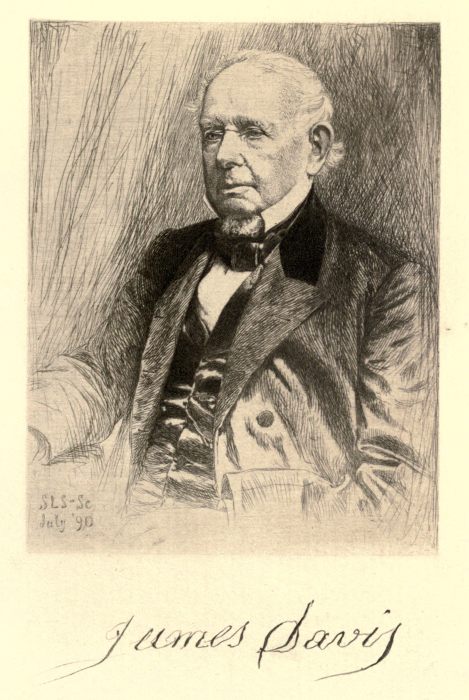
He was a descendant of Robert Davis, who was living in Yarmouth in the year 1643, removing thence to Barnstable in 1650, where he died in 1693 at the age of seventy-one. Of him it is said that "he was not a man of wealth, nor distinguished in political life," but "his character for honesty and industry he transmitted to his posterity."[7]
Mr. James Davis, the subject of this sketch, was the third in descent of that name.
At the age of fourteen he was bound an apprentice to a Mr. Crocker,—who was also originally from Barnstable,—a pewterer, [Pg 19]carrying on business at the "South End" in Boston, not far from where stood the mansion house of the late Mr. John D. Williams. Shortly after the apprenticeship of Mr. Davis began, Mr. Crocker secured the services of a Hessian,—supposed to be a deserter from the British army,—who understood and communicated the art of making castings of brass and copper. From this time and from this beginning, as Mr. Davis firmly believed, ships built in New England were fastened with bolts, spikes, etc., made of composition instead of iron as had formerly been the invariable practice. Mr. Crocker was a man of somewhat irregular habits, and not infrequently severe in his treatment of the apprentices, of whom, as was then quite a common custom, he always had several. At this time it happened that they all revolted and left him, save Mr. Davis, the youngest of the number. He[Pg 20] remained alone to the end of his term, faithfully complying with every condition of his indenture.
In 1800 Mr. Davis, then twenty-three years of age, hired a shop on Union Street, and started in business for himself as a brass founder. He was in some way connected with Martin Gay, a proscribed and banished royalist of the American Revolution and an absentee from 1776 to 1792.[8] On the return of Mr. Gay in the last-named year he resumed his trade, of a coppersmith probably, on the property in Union Street, which had meanwhile been held and occupied by his wife Ruth, and whose dower therein had been set off to her by the Probate Court. Mr. Gay is thereafter denominated a founder, a designation it is[Pg 21] thought he may have derived from his employment of, or association with, Mr. Davis. Mr. Gay subsequently proposed to Mr. Davis to sell to him the business, and further to aid him with such pecuniary assistance as he might require in its prosecution. This proposition was finally accepted, but not without some considerable hesitation on the part of Mr. Davis, as he had no security to offer for the indebtedness involved. No security was required, nor was any ever given, but the transaction was fully completed by a transfer, and by its ultimate payment without default. In 1807 the remainder of Mr. Gay's original interest in the real estate was conveyed by commissioners, under a special Act of the Legislature, to his wife, who had never swerved from her loyalty to the newly formed government. After Mr. Gay's death, in 1809, Mr. Davis bought the estate from the widow, and the property, as enlarged by several[Pg 22] subsequent purchases, still remains in possession of his heirs.[9]
He occupied the entire premises with his foundry, shop, and residence, for many years; associated with himself his son, Mr. James Davis, Jr., as a partner, January 4, 1828, and finally merged the business into the Revere Copper Company, as already stated.
Upon the organization of the Company he was elected Treasurer, and held that office until January 22, 1843. He was also a Director until his death, which took place very suddenly at his house on Tremont Street, Boston, April 25, 1862.
He was persistently industrious, thrifty, and scrupulously upright in every transaction,—qualities transmitted to him from his ancestor Robert,—and generous withal to every proper claim upon him. He gloried in his early[Pg 23] struggles to overcome adverse conditions, and was gratified to be numbered with those from his native town who had achieved honorable distinction in the various activities of life.
There was a ruggedness and sharpness of vigor about him which was lost sight of as he ripened and mellowed in a conspicuous manner under the influences of ampler means and advancing years. The simple tastes and quiet ways of his boyhood home were however to the end more attractive and satisfactory to him than the demands and restraints of an increasingly artificial life.
That he was wise and farsighted is abundantly shown by the fact that all his real estate investments are held intact to this day by his heirs.
[7] From "Notes of Barnstable Families," lately published by Mr. F. B. Goss.
[8] Sabine's "Loyalists of the American Revolution," 1864, vol. i, page 466.
Martin Gay was a son of the Rev. Ebenezer Gay, pastor of the First Church in Hingham for the remarkably long period of sixty-eight years, nine months, and seventeen days. See "History of the Town of Hingham," by Solomon Lincoln, Jr., 1827, pages 26-30.
Captain Martin Gay was one of the firewards elected at the town meeting, March 13, 1769.—Drake's History of Boston, page 756.
[9] The foregoing is taken largely from Mr. Joseph T. Buckingham's Letter, No. XVII, in The Saturday Evening Gazette of May 21, 1859. It is understood that the facts contained therein were obtained by him directly from Mr. Davis.
Frederick Walker Lincoln was the son of Amos and Deborah (Revere) Lincoln, and was born in Boston June 12, 1796.
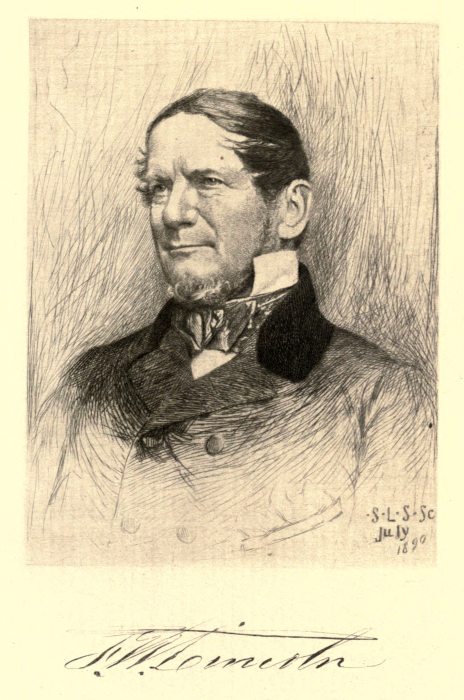
His father was a descendant of Samuel Lincoln, who came to Salem from Norwich,[10] England, in 1637, subsequently removing to Hingham. The father was a conspicuous leader in the destruction of tea from British ships in Boston Harbor, and was captain of an artillery company in the Revolutionary War. He was constantly associated with Colonel Paul Revere, and between them there always existed the most cordial relations and the utmost confidence.
His mother was the eldest daughter of Colonel Revere.
Upon his mother's death, in April, 1797, Mr. Lincoln, as an infant, was taken into his grandfather Revere's family, where he remained until the grandfather died, in 1818.
He received his business education with the firm of Paul Revere & Son, continuing with the son, Mr. J. W. Revere, after the father's death. At one time he was in Philadelphia for a year or two adjusting the affairs of their agency, which under a previous management had fallen into some disorder.
He was married to Miss Amelia Howard, of Boston, in August, 1819. She survived him, dying there March 25, 1874.
Upon the organization of the Company he was placed in charge of the works, as resident agent, at Canton. He retired from that position September 11, 1858; was elected President, succeeding his uncle, Mr. J. W. Revere, January 4, 1869, and died at his home in Boston, January 10, 1871, leaving no children.
He visited England in 1843, being absent from home on the trip only about three months.
Unambitious and passionately fond of his home, he was seldom away from it, and accordingly led an extremely quiet and uneventful life.
He was public-spirited, taking a lively interest in town and county affairs; was for a time President of the Neponset Bank, and also President of the Stoughton Branch Railroad Company. He was fond of outdoor and military life; was a member of the Boston Hussars, a somewhat famous corps, under the command of Hon. Josiah Quincy, and later a member of the Boston Cadets. He was an aide on the staff of Governor Gardner, and subsequently senior aide on the staff of Governor Washburn.
Patriotic and conservative in politics, he naturally allied himself with the Whig party,[Pg 27] upon the dissolution of which, and during the last war, he was a staunch Republican.
Moderate in his views, unaggressive in his plans, and absolutely without display, he provoked no antagonisms. Genial in disposition, quick and ready with his sympathy, and always a cheerful helper, he attached his neighbors and associates to him very warmly. He was popular not only with men of his own generation, but with a class somewhat younger than himself, and his memory is still cherished by many of them.
[10] From a Genealogical Memorandum in possession of Hon. F. W. Lincoln.
Cushing's MSS., however, quoted by Mr. Solomon Lincoln, Jr., in his "History of Hingham," has the following record: "1637. John Tower and Samuel Lincoln came from old Hingham, and both settled at new Hingham; Samuel Lincoln living some time at Salem."
James Davis, Jr., eldest son of the James already sketched, and Hannah (Ingols) Davis, was born in his father's house No. 15 Prince Street, Boston, April 23, 1806, and was the fourth in descent of that name.
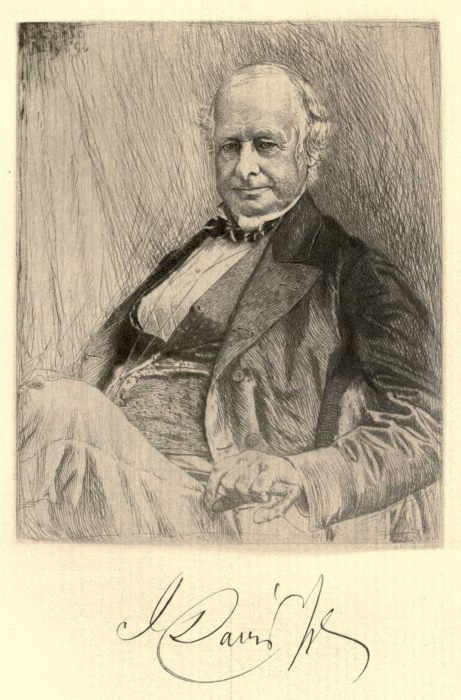
He received his education partly in the public schools of Boston, and subsequently as a private pupil residing in the family of his teacher, the Rev. Joseph Richardson, for many years Pastor of the First Church in Hingham. He is spoken of as "a quietly behaved and rather sedate boy" by a gentleman now living who remembers him at the time.[11]
His business career began in the office of Messrs. Josiah Bradlee & Co., then on India [Pg 29]Street. Graduating therefrom in the year 1827, he was shortly after admitted to partnership with his father, under the firm-name of James Davis & Son.
Immediately upon the organization of the Company, he was appointed the agent in Boston. He was elected Treasurer January 22, 1843, and continued to fill this latter office until his retirement from active business, February 27, 1872. During all this time,—from 1828 to 1872,—covering a period of forty-four years, he managed the affairs of the Company with untiring energy and consummate skill. Upon the death of Mr. Lincoln he was made President, filling that position until his own death, May 28, 1881.
He was never married and the family name, in this branch, became extinct upon his death.
He visited England for the first time in 1835, and subsequently made several trips[Pg 30] abroad, traveling considerably, on one occasion making an excursion up the Nile.
He accumulated quite a large general library; read and observed intelligently, and was well informed on the current topics of the time.
Having a strong, imperious will, he could with difficulty brook any opposition; but his intentions were just and his impulses generous. Exact and exacting, demanding, however, no more of others than he required of himself; energetic, enterprising, sagacious, and bold, his ability and his high standing as an accomplished merchant were indicated by his success, and were readily recognized by the community in which his work was done. His character for integrity and honorable dealing secured to him the esteem of those having any transactions with him.
It is cheerfully and gratefully acknowledged that whatever there may be of real value in[Pg 31] the present management of the Company is very largely due to his careful and practical teaching and the decided impress upon it of his wise, able, and successful administration.
[11] Luther Stephenson, Esq., in his eighty-sixth year, residing with his son General Luther Stephenson, Jr., Governor of the Soldiers' Home at Togus, Maine.
John Revere was the eldest son of Joseph W. and Mary (Robbins) Revere, and was born while his parents were living at No. 7 Federal Street, Boston, March 31, 1822.
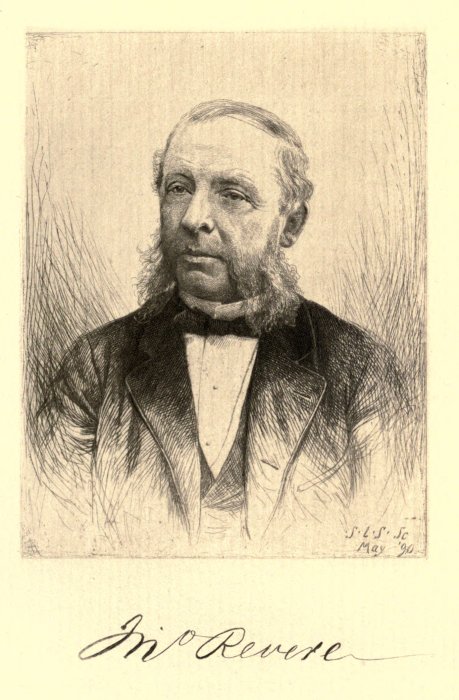
He attended the public schools in Boston, and for a time Mr. Thayer's school in Milton, which meanwhile was removed to Jamaica Plain; was fitted for college in the Boston Latin School under Master Dillaway; entered Harvard College and graduated therefrom in the class of 1841.
Immediately after his graduation he entered the office of Messrs. A. & C. Cunningham, on Rowe's Wharf, where he remained until April, 1843, when he went out to Cronstadt in the brig Kazan, Captain Leckie. After leaving the brig on her arrival out, he travel[Pg 33]ed abroad until December of that year. Mr. Lincoln, whose visit to England has already been mentioned, met Mr. Revere in London during his stay there.
He was admitted to the business during the following year, acquiring stock which was transferred to him January 11, 1845, and was elected clerk of the Corporation on the same day. He was made acting agent in Boston January 17, 1846; assumed charge of the mills at Canton on the retirement of Mr. Lincoln, September 11, 1858; was elected Treasurer July 1, 1872, and finally chosen President, July 5, 1881, remaining in this last position until his death.
Amiable, tender, and sensitive to a very extraordinary degree, he was constantly sacrificing himself for others. He would rather at any time suffer himself than run any risk of disappointing or inconveniencing another. This course unfortunately prepared for him[Pg 34] burdens and complications that ultimately troubled and worried him a good deal.
Every instinct of his nature was upright. He was absolutely incapable of a mercenary thought or purpose.
In many ways he was certainly unsuited for a business life. He had no love for it. It was a competition and struggle for preferment, place, or gain—a selfish strife—utterly distasteful to him. He had a fondness for literature, read understandingly, possessed an uncommon memory, and had the faculty of expressing himself in writing with unusual felicity, indicating perhaps the path wherein he might have been eminently successful. His own preferences were, however, never permitted by him to weigh against the plans or wishes of his father.
It seemed to be impossible for him to turn away unaided an applicant for assistance, especially if a soldier, or belonging to[Pg 35] a soldier's family. The presence of his two brothers in the army; their active work and death, naturally attracted and interested him in all the events and participants of the war. His interest in everything that pertained to the Rebellion was never in the least abated, and he was distinguished for his intimate and exact knowledge of the formation, positions, and movements of the army.
Never conspicuous for his physical vigor, he finally fell into a decline, resulting, after a weary and wearing illness of nearly two years, in his death, which took place at his home in Canton, July 26, 1886.[12]
It was my fortune to be associated with him for a period of more than forty years in relations that naturally ripened into an intimacy of the most cordial confidence; and it is now a gratification to me to cherish[Pg 36] the recollection of his many excellent qualities, and to do what I may by an honest loyalty to guard and preserve his memory.
[12] Two of Mr. Revere's sons are actively engaged with the Company—Mr. William Bacon Revere, in charge at Canton, and Mr. Edward Hutchinson Robbins Revere, in the Boston office.
Frederick William Davis, brother of the foregoing James Davis, Jr., was the third son and youngest child of James and Hannah (Ingols) Davis, and was born while the family resided at No. 19 (afterward 23) Union Street, Boston, April 10, 1824.
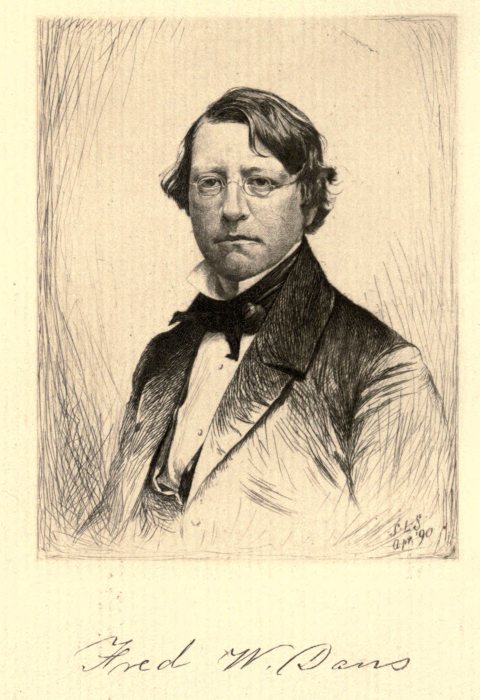
He attended for some time the public schools of Boston, completing his education in Mr. Greene's school at Jamaica Plain.
Entering the office of Messrs. Philo S. Shelton & Co., on India Wharf, some time in the early part of 1840, where he remained for about two years.
He withdrew from his position there to obtain a knowledge of mineralogy and chemistry under the careful and thorough teaching[Pg 38] of the late Dr. Charles T. Jackson, accompanying him in his exploration of 1844 on Lake Superior.
He came into the Company after the establishment of the smelting-works at Point Shirley, having some shares transferred to him December 31, 1850; was the resident agent there, continuing such until his death, from typhoid fever, December 11, 1854.
He took very high rank as an analytical chemist; was devoted, industrious, and able in the department assigned to him. He is spoken of in a published description of the Point Shirley works as of "great ability, and in his day having few equals and certainly no superior."[13]
Unselfish and generous, he was a warm and steadfast friend. On any occasion for[Pg 39] it his helpfulness was ungrudging and unstinted, regardless alike of cost or exertion.
His early death prematurely closed a career which under circumstances wisely improved might have been an extremely brilliant one.
Those who knew him most familiarly still remember his cheery, cordial greeting, and his hearty response to their sincere regard for him.
The following obituary notice of him was written by Dr. Jackson.[14]
"We have to record the death of one of our excellent practical chemists and metallurgists, Frederick W. Davis, of Boston, who died at his father's house, of typhoid fever, on the 12th of December last, at the age of thirty-one years. Mr. Davis received a good education at the school of Mr. Greene, of Jamaica Plains, in Roxbury, and was then[Pg 40] placed under the scientific instruction of Dr. Charles T. Jackson, in whose laboratory he pursued his studies with great diligence and success, for three years.
"In 1844 he accompanied Dr. Jackson in his early explorations of the copper regions of Lake Superior, and distinguished himself as an active and faithful explorer of the mineral district on Keweenaw Point. In 1847 he was appointed by the Revere Copper Company as Superintendent of their copper-smelting furnaces at Point Shirley, which he conducted with signal ability from that time until he was seized with the fever of which he died. While attending to the active and complicated business of the copper-works, making all the assays of ores, fluxes, furnace slags, and of the crude copper produced, he found time to make many interesting and important metallurgical researches, and many scientific observations and [Pg 41]experiments on the formation of artificial minerals, both in the furnace and in the roasting heaps of copper ores. He produced a new mineral, composed of the sulphurets of zinc and copper, which was found in brilliant black crystals in the roasted ores. He pointed out several new forms of crystals in the slags from his blast furnaces, and he also beautifully illustrated the theory of the formation of native copper from the vaporized chloride of copper, while working the Atacamite of Peru.
"The most important of his labors were of an eminently practical nature, such as discovering the best and most economical methods of mixing the various copper ores of commerce, so as to make one ore flux another, and thus to obtain the largest yield of metal at the least expense.
"Science and the arts have met with a great loss in the death of this young [Pg 42]metallurgist, whose labors were calculated to render efficient services to mankind and to raise the business of the working furnace to the rank of a truly chemical art and science.
"His numerous friends and acquaintances well knew his worth as a man and a friend; always generous, considerate, and kind, and never wanting in public spirit when occasion called him out, he was both respected and beloved by all who knew him."
[13] See an article by T. Egleston, PH.D., in "The Book of Mines," vol. vii, No. 4, July, 1886.
[14] The American Journal of Science and Arts, vol. xix, page 448.
Henry Winsor was the eldest son of Thomas and Welthia (Sprague) Winsor, and was born in Duxbury, Mass., December 31, 1803.
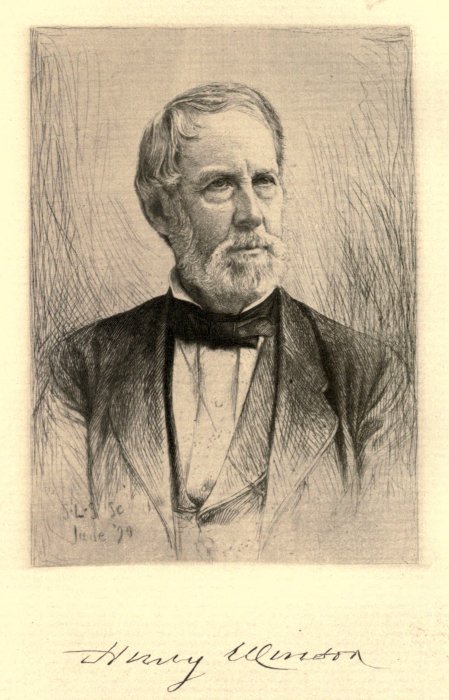
He began his business education in the office of Mr. Joseph Ballister, on Central Wharf, in Boston, at the age of sixteen; subsequently taking a position in his father's office, with whom his uncles, Phineas and Seth Sprague, became associated, where he remained until his father's death, in 1832.
On the twenty-ninth of May, in that year, he was married to Miss Mary Ann Davis, the eldest daughter of Mr. James Davis, here-inbefore sketched.[15] She was born in Boston,[Pg 44] December 3, 1808, and died there, from an accident, September 27, 1881.
A business venture on his own account resulted disastrously from certain operations during the Eastern land speculation of 1835, into which he was drawn.
Still later he was, by appointment of the Court, employed as assignee in the settlement of estates under the National Bankrupt Act of 1841; then became a member of the firm of Phineas Sprague & Co., until, in 1852, he removed to Philadelphia to take charge of a steamship line about to be established.
This line, under his wise, careful, and energetic management, proved a complete success. Beginning with two steamers of five hundred tons each, it has been gradually expanded until it has now a fleet of seven steamers, aggregating nine thousand tons, running from Philadelphia to Boston, to Providence, and to Fall River. It was incorporated in 1872[Pg 45] as the Boston and Philadelphia Steamship Company, of which Mr. Winsor was president from that time until his death.
His business capacity and sterling integrity were soon recognized in Philadelphia, where he became prominent in every effort to advance the public good. The confidence reposed in him was indicated by the numerous positions of trust to which he was invited—as a member, and for many years president, of the Harbor Commission; a vice-president of the Board of Trade; a director of the Bank of North America, of the Insurance Company of North America, of several coal and iron mining companies, and a manager of the Western Savings Fund Association. He was also a member of the Centennial Board of Finance, to whose labors much of the success of that great exposition was due. In all these he did his full portion of the work, bringing to it his sound judgment and his matured wisdom.
He indulged to some extent his taste for writing. Some of his sketches were published in Littell's Living Age. He printed more than one volume. They are now all out of print, however, excepting "Montrose and other Biographical Sketches," issued anonymously from the press of Soule & Williams, in Boston, 1861. A number of incomplete discussions on financial and economic subjects were found among his papers. A critic writes that "he exhibited much grace of style, elegance of diction, and erudite knowledge."
One who had known him for a long time in connection with some of his public trusts, says:[16] "He was tenacious of his opinions, and they were always formed after thought. He was not easily shaken in his views, but a more just man never lived, and if convinced he was in the wrong he instantly gave way. Never swerved by personal [Pg 47]preference, he did his own thinking and arrived at his own conclusions."
This, however, was a description of him away from his home. Those who knew him more intimately, socially, and in his family, received a warmer, more tender, and loving impression of him. His disposition was so sweet,—no other word will express it as well,—his temperament so equable, that the perplexities of business and the trials of life, of both which he had a full share, neither disheartened nor soured him in the least. He bore misfortunes and suffering without a murmur. A mistake affecting him, if frankly acknowledged, would pass without reproof, and the error would be readily condoned; but any deception or dishonesty—the abuse of his confidence—moved his indignation intensely.
The following is extracted from our own records:—
"He became interested in the business of this Company by a transfer of shares October 17, 1881.
"Upon the death of Mr. John Revere he was chosen Director and President, which offices he continued to fill until his death.
"He never failed to give the active managers of the business the benefit of his large experience and his exceptionally sound judgment. His convictions were positive, frankly expressed, and without the least concealment, but never in the manner of factious criticism. His generous and kindly encouragement, his philosophic estimate of the value of mistakes and misfortunes, were always a support and incentive.
"Until his final sickness his mental powers remained unabated; and he never ceased to give his hearty endorsement to every effort made for the advancement of the business, the good name and stability of the Company.
"His cheerful and inspiring presence, which made his visits here so extremely enjoyable, will be seriously and for a long time sadly missed."
[15] The ceremony was performed by Ralph Waldo Emerson, then pastor of the Second Church, in Boston.
[16] Mr. William R. Tucker, Secretary of the Board of Trade in Philadelphia.
End of the Project Gutenberg EBook of Fifty years with the Revere Copper Co., by
S. T. Snow
*** END OF THIS PROJECT GUTENBERG EBOOK REVERE COPPER CO. ***
***** This file should be named 24423-h.htm or 24423-h.zip *****
This and all associated files of various formats will be found in:
http://www.gutenberg.org/2/4/4/2/24423/
Produced by Martin Pettit and the Online Distributed
Proofreading Team at http://www.pgdp.net (This file was
produced from images generously made available by The
Internet Archive/American Libraries.)
Updated editions will replace the previous one--the old editions
will be renamed.
Creating the works from public domain print editions means that no
one owns a United States copyright in these works, so the Foundation
(and you!) can copy and distribute it in the United States without
permission and without paying copyright royalties. Special rules,
set forth in the General Terms of Use part of this license, apply to
copying and distributing Project Gutenberg-tm electronic works to
protect the PROJECT GUTENBERG-tm concept and trademark. Project
Gutenberg is a registered trademark, and may not be used if you
charge for the eBooks, unless you receive specific permission. If you
do not charge anything for copies of this eBook, complying with the
rules is very easy. You may use this eBook for nearly any purpose
such as creation of derivative works, reports, performances and
research. They may be modified and printed and given away--you may do
practically ANYTHING with public domain eBooks. Redistribution is
subject to the trademark license, especially commercial
redistribution.
*** START: FULL LICENSE ***
THE FULL PROJECT GUTENBERG LICENSE
PLEASE READ THIS BEFORE YOU DISTRIBUTE OR USE THIS WORK
To protect the Project Gutenberg-tm mission of promoting the free
distribution of electronic works, by using or distributing this work
(or any other work associated in any way with the phrase "Project
Gutenberg"), you agree to comply with all the terms of the Full Project
Gutenberg-tm License (available with this file or online at
http://gutenberg.org/license).
Section 1. General Terms of Use and Redistributing Project Gutenberg-tm
electronic works
1.A. By reading or using any part of this Project Gutenberg-tm
electronic work, you indicate that you have read, understand, agree to
and accept all the terms of this license and intellectual property
(trademark/copyright) agreement. If you do not agree to abide by all
the terms of this agreement, you must cease using and return or destroy
all copies of Project Gutenberg-tm electronic works in your possession.
If you paid a fee for obtaining a copy of or access to a Project
Gutenberg-tm electronic work and you do not agree to be bound by the
terms of this agreement, you may obtain a refund from the person or
entity to whom you paid the fee as set forth in paragraph 1.E.8.
1.B. "Project Gutenberg" is a registered trademark. It may only be
used on or associated in any way with an electronic work by people who
agree to be bound by the terms of this agreement. There are a few
things that you can do with most Project Gutenberg-tm electronic works
even without complying with the full terms of this agreement. See
paragraph 1.C below. There are a lot of things you can do with Project
Gutenberg-tm electronic works if you follow the terms of this agreement
and help preserve free future access to Project Gutenberg-tm electronic
works. See paragraph 1.E below.
1.C. The Project Gutenberg Literary Archive Foundation ("the Foundation"
or PGLAF), owns a compilation copyright in the collection of Project
Gutenberg-tm electronic works. Nearly all the individual works in the
collection are in the public domain in the United States. If an
individual work is in the public domain in the United States and you are
located in the United States, we do not claim a right to prevent you from
copying, distributing, performing, displaying or creating derivative
works based on the work as long as all references to Project Gutenberg
are removed. Of course, we hope that you will support the Project
Gutenberg-tm mission of promoting free access to electronic works by
freely sharing Project Gutenberg-tm works in compliance with the terms of
this agreement for keeping the Project Gutenberg-tm name associated with
the work. You can easily comply with the terms of this agreement by
keeping this work in the same format with its attached full Project
Gutenberg-tm License when you share it without charge with others.
1.D. The copyright laws of the place where you are located also govern
what you can do with this work. Copyright laws in most countries are in
a constant state of change. If you are outside the United States, check
the laws of your country in addition to the terms of this agreement
before downloading, copying, displaying, performing, distributing or
creating derivative works based on this work or any other Project
Gutenberg-tm work. The Foundation makes no representations concerning
the copyright status of any work in any country outside the United
States.
1.E. Unless you have removed all references to Project Gutenberg:
1.E.1. The following sentence, with active links to, or other immediate
access to, the full Project Gutenberg-tm License must appear prominently
whenever any copy of a Project Gutenberg-tm work (any work on which the
phrase "Project Gutenberg" appears, or with which the phrase "Project
Gutenberg" is associated) is accessed, displayed, performed, viewed,
copied or distributed:
This eBook is for the use of anyone anywhere at no cost and with
almost no restrictions whatsoever. You may copy it, give it away or
re-use it under the terms of the Project Gutenberg License included
with this eBook or online at www.gutenberg.org
1.E.2. If an individual Project Gutenberg-tm electronic work is derived
from the public domain (does not contain a notice indicating that it is
posted with permission of the copyright holder), the work can be copied
and distributed to anyone in the United States without paying any fees
or charges. If you are redistributing or providing access to a work
with the phrase "Project Gutenberg" associated with or appearing on the
work, you must comply either with the requirements of paragraphs 1.E.1
through 1.E.7 or obtain permission for the use of the work and the
Project Gutenberg-tm trademark as set forth in paragraphs 1.E.8 or
1.E.9.
1.E.3. If an individual Project Gutenberg-tm electronic work is posted
with the permission of the copyright holder, your use and distribution
must comply with both paragraphs 1.E.1 through 1.E.7 and any additional
terms imposed by the copyright holder. Additional terms will be linked
to the Project Gutenberg-tm License for all works posted with the
permission of the copyright holder found at the beginning of this work.
1.E.4. Do not unlink or detach or remove the full Project Gutenberg-tm
License terms from this work, or any files containing a part of this
work or any other work associated with Project Gutenberg-tm.
1.E.5. Do not copy, display, perform, distribute or redistribute this
electronic work, or any part of this electronic work, without
prominently displaying the sentence set forth in paragraph 1.E.1 with
active links or immediate access to the full terms of the Project
Gutenberg-tm License.
1.E.6. You may convert to and distribute this work in any binary,
compressed, marked up, nonproprietary or proprietary form, including any
word processing or hypertext form. However, if you provide access to or
distribute copies of a Project Gutenberg-tm work in a format other than
"Plain Vanilla ASCII" or other format used in the official version
posted on the official Project Gutenberg-tm web site (www.gutenberg.org),
you must, at no additional cost, fee or expense to the user, provide a
copy, a means of exporting a copy, or a means of obtaining a copy upon
request, of the work in its original "Plain Vanilla ASCII" or other
form. Any alternate format must include the full Project Gutenberg-tm
License as specified in paragraph 1.E.1.
1.E.7. Do not charge a fee for access to, viewing, displaying,
performing, copying or distributing any Project Gutenberg-tm works
unless you comply with paragraph 1.E.8 or 1.E.9.
1.E.8. You may charge a reasonable fee for copies of or providing
access to or distributing Project Gutenberg-tm electronic works provided
that
- You pay a royalty fee of 20% of the gross profits you derive from
the use of Project Gutenberg-tm works calculated using the method
you already use to calculate your applicable taxes. The fee is
owed to the owner of the Project Gutenberg-tm trademark, but he
has agreed to donate royalties under this paragraph to the
Project Gutenberg Literary Archive Foundation. Royalty payments
must be paid within 60 days following each date on which you
prepare (or are legally required to prepare) your periodic tax
returns. Royalty payments should be clearly marked as such and
sent to the Project Gutenberg Literary Archive Foundation at the
address specified in Section 4, "Information about donations to
the Project Gutenberg Literary Archive Foundation."
- You provide a full refund of any money paid by a user who notifies
you in writing (or by e-mail) within 30 days of receipt that s/he
does not agree to the terms of the full Project Gutenberg-tm
License. You must require such a user to return or
destroy all copies of the works possessed in a physical medium
and discontinue all use of and all access to other copies of
Project Gutenberg-tm works.
- You provide, in accordance with paragraph 1.F.3, a full refund of any
money paid for a work or a replacement copy, if a defect in the
electronic work is discovered and reported to you within 90 days
of receipt of the work.
- You comply with all other terms of this agreement for free
distribution of Project Gutenberg-tm works.
1.E.9. If you wish to charge a fee or distribute a Project Gutenberg-tm
electronic work or group of works on different terms than are set
forth in this agreement, you must obtain permission in writing from
both the Project Gutenberg Literary Archive Foundation and Michael
Hart, the owner of the Project Gutenberg-tm trademark. Contact the
Foundation as set forth in Section 3 below.
1.F.
1.F.1. Project Gutenberg volunteers and employees expend considerable
effort to identify, do copyright research on, transcribe and proofread
public domain works in creating the Project Gutenberg-tm
collection. Despite these efforts, Project Gutenberg-tm electronic
works, and the medium on which they may be stored, may contain
"Defects," such as, but not limited to, incomplete, inaccurate or
corrupt data, transcription errors, a copyright or other intellectual
property infringement, a defective or damaged disk or other medium, a
computer virus, or computer codes that damage or cannot be read by
your equipment.
1.F.2. LIMITED WARRANTY, DISCLAIMER OF DAMAGES - Except for the "Right
of Replacement or Refund" described in paragraph 1.F.3, the Project
Gutenberg Literary Archive Foundation, the owner of the Project
Gutenberg-tm trademark, and any other party distributing a Project
Gutenberg-tm electronic work under this agreement, disclaim all
liability to you for damages, costs and expenses, including legal
fees. YOU AGREE THAT YOU HAVE NO REMEDIES FOR NEGLIGENCE, STRICT
LIABILITY, BREACH OF WARRANTY OR BREACH OF CONTRACT EXCEPT THOSE
PROVIDED IN PARAGRAPH F3. YOU AGREE THAT THE FOUNDATION, THE
TRADEMARK OWNER, AND ANY DISTRIBUTOR UNDER THIS AGREEMENT WILL NOT BE
LIABLE TO YOU FOR ACTUAL, DIRECT, INDIRECT, CONSEQUENTIAL, PUNITIVE OR
INCIDENTAL DAMAGES EVEN IF YOU GIVE NOTICE OF THE POSSIBILITY OF SUCH
DAMAGE.
1.F.3. LIMITED RIGHT OF REPLACEMENT OR REFUND - If you discover a
defect in this electronic work within 90 days of receiving it, you can
receive a refund of the money (if any) you paid for it by sending a
written explanation to the person you received the work from. If you
received the work on a physical medium, you must return the medium with
your written explanation. The person or entity that provided you with
the defective work may elect to provide a replacement copy in lieu of a
refund. If you received the work electronically, the person or entity
providing it to you may choose to give you a second opportunity to
receive the work electronically in lieu of a refund. If the second copy
is also defective, you may demand a refund in writing without further
opportunities to fix the problem.
1.F.4. Except for the limited right of replacement or refund set forth
in paragraph 1.F.3, this work is provided to you 'AS-IS' WITH NO OTHER
WARRANTIES OF ANY KIND, EXPRESS OR IMPLIED, INCLUDING BUT NOT LIMITED TO
WARRANTIES OF MERCHANTIBILITY OR FITNESS FOR ANY PURPOSE.
1.F.5. Some states do not allow disclaimers of certain implied
warranties or the exclusion or limitation of certain types of damages.
If any disclaimer or limitation set forth in this agreement violates the
law of the state applicable to this agreement, the agreement shall be
interpreted to make the maximum disclaimer or limitation permitted by
the applicable state law. The invalidity or unenforceability of any
provision of this agreement shall not void the remaining provisions.
1.F.6. INDEMNITY - You agree to indemnify and hold the Foundation, the
trademark owner, any agent or employee of the Foundation, anyone
providing copies of Project Gutenberg-tm electronic works in accordance
with this agreement, and any volunteers associated with the production,
promotion and distribution of Project Gutenberg-tm electronic works,
harmless from all liability, costs and expenses, including legal fees,
that arise directly or indirectly from any of the following which you do
or cause to occur: (a) distribution of this or any Project Gutenberg-tm
work, (b) alteration, modification, or additions or deletions to any
Project Gutenberg-tm work, and (c) any Defect you cause.
Section 2. Information about the Mission of Project Gutenberg-tm
Project Gutenberg-tm is synonymous with the free distribution of
electronic works in formats readable by the widest variety of computers
including obsolete, old, middle-aged and new computers. It exists
because of the efforts of hundreds of volunteers and donations from
people in all walks of life.
Volunteers and financial support to provide volunteers with the
assistance they need, is critical to reaching Project Gutenberg-tm's
goals and ensuring that the Project Gutenberg-tm collection will
remain freely available for generations to come. In 2001, the Project
Gutenberg Literary Archive Foundation was created to provide a secure
and permanent future for Project Gutenberg-tm and future generations.
To learn more about the Project Gutenberg Literary Archive Foundation
and how your efforts and donations can help, see Sections 3 and 4
and the Foundation web page at http://www.pglaf.org.
Section 3. Information about the Project Gutenberg Literary Archive
Foundation
The Project Gutenberg Literary Archive Foundation is a non profit
501(c)(3) educational corporation organized under the laws of the
state of Mississippi and granted tax exempt status by the Internal
Revenue Service. The Foundation's EIN or federal tax identification
number is 64-6221541. Its 501(c)(3) letter is posted at
http://pglaf.org/fundraising. Contributions to the Project Gutenberg
Literary Archive Foundation are tax deductible to the full extent
permitted by U.S. federal laws and your state's laws.
The Foundation's principal office is located at 4557 Melan Dr. S.
Fairbanks, AK, 99712., but its volunteers and employees are scattered
throughout numerous locations. Its business office is located at
809 North 1500 West, Salt Lake City, UT 84116, (801) 596-1887, email
business@pglaf.org. Email contact links and up to date contact
information can be found at the Foundation's web site and official
page at http://pglaf.org
For additional contact information:
Dr. Gregory B. Newby
Chief Executive and Director
gbnewby@pglaf.org
Section 4. Information about Donations to the Project Gutenberg
Literary Archive Foundation
Project Gutenberg-tm depends upon and cannot survive without wide
spread public support and donations to carry out its mission of
increasing the number of public domain and licensed works that can be
freely distributed in machine readable form accessible by the widest
array of equipment including outdated equipment. Many small donations
($1 to $5,000) are particularly important to maintaining tax exempt
status with the IRS.
The Foundation is committed to complying with the laws regulating
charities and charitable donations in all 50 states of the United
States. Compliance requirements are not uniform and it takes a
considerable effort, much paperwork and many fees to meet and keep up
with these requirements. We do not solicit donations in locations
where we have not received written confirmation of compliance. To
SEND DONATIONS or determine the status of compliance for any
particular state visit http://pglaf.org
While we cannot and do not solicit contributions from states where we
have not met the solicitation requirements, we know of no prohibition
against accepting unsolicited donations from donors in such states who
approach us with offers to donate.
International donations are gratefully accepted, but we cannot make
any statements concerning tax treatment of donations received from
outside the United States. U.S. laws alone swamp our small staff.
Please check the Project Gutenberg Web pages for current donation
methods and addresses. Donations are accepted in a number of other
ways including checks, online payments and credit card donations.
To donate, please visit: http://pglaf.org/donate
Section 5. General Information About Project Gutenberg-tm electronic
works.
Professor Michael S. Hart is the originator of the Project Gutenberg-tm
concept of a library of electronic works that could be freely shared
with anyone. For thirty years, he produced and distributed Project
Gutenberg-tm eBooks with only a loose network of volunteer support.
Project Gutenberg-tm eBooks are often created from several printed
editions, all of which are confirmed as Public Domain in the U.S.
unless a copyright notice is included. Thus, we do not necessarily
keep eBooks in compliance with any particular paper edition.
Most people start at our Web site which has the main PG search facility:
http://www.gutenberg.org
This Web site includes information about Project Gutenberg-tm,
including how to make donations to the Project Gutenberg Literary
Archive Foundation, how to help produce our new eBooks, and how to
subscribe to our email newsletter to hear about new eBooks.